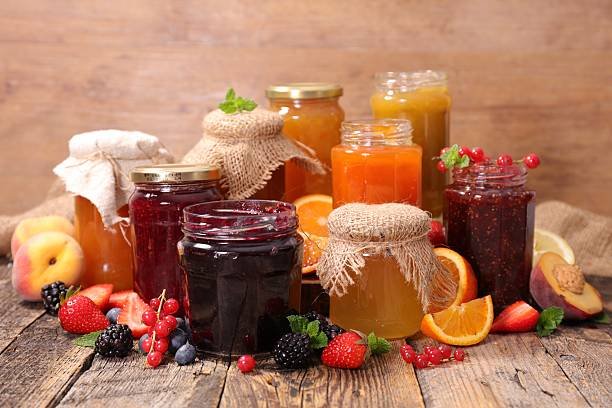How to make Sweet preserves.
Sweet condiments such as jams, jellies, preserves, conserves, marmalades, fruit butter, and syrups are the “something extra” that we like to indulge in sometimes. Toast may become breakfast with only a dollop, and pancakes can become a feast with just as little.
The question now is, how do the many kinds of sweet condiments vary from one another?
In contrast to jelly, which is prepared only from the fruit’s juice and does not include even the tiniest bit of pulp, jam is made using actual bits of the fruit that it is formed from.
Although any kind of sweet fruit spread can be referred to as a preserve, technically speaking, preserves are made with whole small fruits rather than chopped fruit. Examples of such fruits include cherries and blueberries.
However, even commercial brands use the terms jam and preserve interchangeably. A conserve is quite similar to jam or preserves, with the exception that it also contains nuts and dried fruit. Marmalades are manufactured from citrus fruits and often contain slivers of the rinds in their composition.
Fruit butter are nothing more than fruit purées like applesauce that have been reduced to a spreadable consistency by cooking. Syrups are sweet pourable liquids.
What Makes It a Risk-Free Option?
Sugar is not required for the creation of sweet preserves; nevertheless, preserves prepared with sugar have a longer shelf life than those made without sugar. Despite this, the sugar that is used in fruit preserves is not the primary factor that contributes to their ability to be securely preserved.
Sugar, which has a pH of 7, is not capable of bringing the pH of a recipe down to a level that is low enough to prevent the development of germs that are hazardous to humans. It is, rather, the acidity of the fruit that is responsible for this effect.
The acidity of the ingredients is the primary factor that prevents mold growth and ensures the food is securely preserved even though sweet preserves may be treated in a boiling water bath to seal the jars and prevent mold growth.
On the pH scale, fruits have a lower value, which means that they may be safely canned in boiling water without risk of spoilage.
In spite of the fact that sugar has very little impact on the longevity of sweet preserves, sugar is responsible for the formation of a gel by forming bonds with the pectin found in fruit.
Because of this, if you lower the amount of sugar in a jelly recipe below what is asked for, you may wind up with something that is too runny to spread over toast (in this case, you should simply call it syrup and put it on your pancakes instead).
The gleaming, velvety, and not-quite-liquid consistency that is typical of most types of sweet preserves is produced by dissolving sugar in acid and pectin while the mixture is being heated to high temperatures.
MAKING LOW-OR NO-SUGAR PRESERVES
Using a certain kind of low-methoxyl pectin is necessary in order to make jams, jellies, and other kinds of sweet preserves with very little or no sugar at all and yet have them gel properly.
If you place an order for low-methoxyl pectin like the one described in Useful Resources, it will arrive with a packet of calcium powder and comprehensive instructions for its use.
Because of the synergistic effect of the low-methoxyl pectin and the calcium powder, even sugar-free recipes may be made to gel properly.
sugar-free recipes to gel.
If cutting down on sugar in your diet is a priority for you, I strongly suggest looking into low-methoxyl pectin. However, the consistency of the preserves produced with this product is not the same as that of preserves produced using sugar.
For instance, sugar-free jelly that is produced using low-methoxyl pectin might have a texture that is more like that of Jell-O than that of jelly.
Pectin is a chemical that occurs naturally and may be found in the majority of fruits. Underripe fruits have a greater pectin content than fully ripe fruits do, and some fruits have a naturally higher pectin content than others.
You have three options to choose from when dealing with low-pectin fruits like strawberries, which include the following: You have the option of using pectin in the recipe, combining the low-pectin fruit with a high-pectin fruit, or cooking the low-pectin fruit for an extended period of time in order to remove enough water so that the jam may be thickened.
Because the final choice strips the fruit of a significant amount of its color and taste, I do not advocate using it.
HIGH-AND LOW-PECTIN FRUIT
When you look up the fruit that you want to preserve, keep in mind that if it is on the low-pectin list, you will need to either add pectin to it or pair it with a fruit that is rich in pectin. If it is on the high-pectin list, you may preserve it as is.
The vast majority of pectins sold in stores are either powders or liquids, and they get their pectin from either apples or citrus fruits. These are not my favorite for the simple reason that the majority of recipes that call for commercial pectins also call for a significant quantity of sugar.
In the end, all you can taste is the sugar, not the actual fruit. The good news is that it is not difficult at all to create pectin on your own, and if you make your own pectin, you may use substantially less sugar when making preserves.
Quick Refrigerator Dill Pickles






